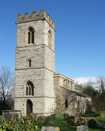For this church:    |
|
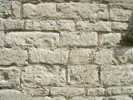 Skerry blocks Skerry blocks |
The tower and east end of the church is made of large pale grey blocks of Dolomitic ‘skerry’ sandstone. This stone is hard and difficult to work and is resistant to weathering. The stone may have come from local quarries such as Tuxford, Maplebeck, Laxton or Kneesall. It has not been available for over 100 years.
The following stones are also found:
 Rubble Rubble |
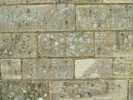 Lincolnshire Lincolnshirelimestone |
 Lincolnshire limestone (Middle Jurassic) jumbled in the north wall, east end, the tower string course, north buttress and vestry. The replacement pillar in the south doorway is made of this stone.
Lincolnshire limestone (Middle Jurassic) jumbled in the north wall, east end, the tower string course, north buttress and vestry. The replacement pillar in the south doorway is made of this stone.
 Magnesian limestone (Dolomitic). It is hard and difficult to work and would have come from a Mansfield quarry. It is found in the frame of the south doorway and in horizontal stones in the old door frame on the north side of the church. It is also found around windows.
Magnesian limestone (Dolomitic). It is hard and difficult to work and would have come from a Mansfield quarry. It is found in the frame of the south doorway and in horizontal stones in the old door frame on the north side of the church. It is also found around windows.
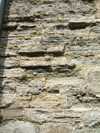 Lias Lias |
 Lias (Lower Jurassic limestone) in small quantities in the inserts in the doorway on the south side of the chancel. This may have come across the river from Collingham. It is also found in Newark Friary.
Lias (Lower Jurassic limestone) in small quantities in the inserts in the doorway on the south side of the chancel. This may have come across the river from Collingham. It is also found in Newark Friary.
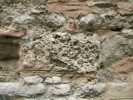 Tufa Tufa |
 Tufa is found in the west end of the south aisle. It is porous and light and is likely to have been found locally. It can still be found along the Beck between Norwell and Caunton and is used abundantly in Caunton church.
Tufa is found in the west end of the south aisle. It is porous and light and is likely to have been found locally. It can still be found along the Beck between Norwell and Caunton and is used abundantly in Caunton church.
 Millstone grit is found in the quoins on the north wall. It is hard and resistant to weathering. It would have come from Derbyshire or Rotherham.
Millstone grit is found in the quoins on the north wall. It is hard and resistant to weathering. It would have come from Derbyshire or Rotherham.
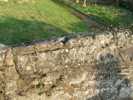 Wall coping Wall coping |
Churchyard
Most of the headstones are made of Mansfield limestone, although a few are made of slate. The churchyard wall is made of ‘skerry’ blocks and Lincolnshire limestone. These are likely to have been re-used. Note the presence of hogback stones forming some of the coping which may date to the earliest days of the church.
With thanks to Dr Graham Lott for his help with identifying the stones.


